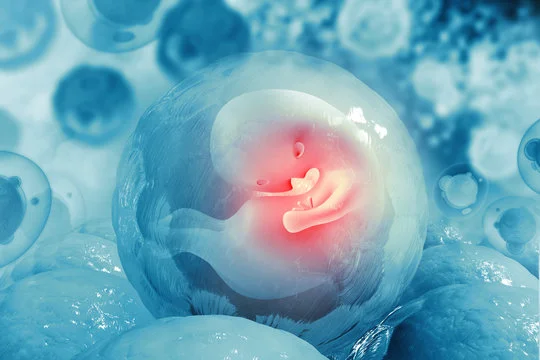How Long Does Frozen Embryo Transfer Take?

Frozen embryo transfer (FET) is a crucial step in the in vitro fertilization (IVF) process, offering many couples the opportunity to have children. FET is used when embryos that were created from an earlier IVF cycle are stored in a cryopreserved state and transferred to the woman's uterus at a later time. The process is highly effective and convenient, allowing patients to take advantage of embryos that were previously frozen.
What is Frozen Embryo Transfer?
Frozen embryo transfer is a part of IVF treatment. During IVF, eggs are retrieved from the woman’s ovaries and fertilized with sperm in a laboratory. The resulting embryos are then cultured for several days before being frozen for future use. This gives patients flexibility, allowing the embryo transfer to take place at a time that’s more optimal for the woman's body or lifestyle.
FET is typically performed when the patient's uterus is in the right condition for implantation, which could be in a subsequent IVF cycle, allowing for the transfer of the embryo at a later stage. The frozen embryos are thawed and then transferred into the uterus to achieve pregnancy.
What Does the Frozen Embryo Transfer Process Involve?
The FET process involves several steps, and each of these steps takes time. Below is a breakdown of what typically happens:
-
Initial Consultation and Pre-Treatment Preparation:
- The first step in preparing for FET is a consultation with your fertility doctor. During this visit, the doctor will assess your overall health and determine the best course of action for your frozen embryo transfer.
- Tests may be performed to check the health of your uterus, including a transvaginal ultrasound to check the thickness of the endometrial lining and ensure that there are no abnormalities.
- You may also undergo blood tests to check hormone levels to ensure that your body is ready for embryo transfer. These levels are crucial for successful implantation.
- The first step in preparing for FET is a consultation with your fertility doctor. During this visit, the doctor will assess your overall health and determine the best course of action for your frozen embryo transfer.
-
Hormonal Preparation:
- After the initial evaluation, hormonal therapy is started. This typically involves a regimen of estrogen and progesterone. Estrogen helps prepare the uterine lining (endometrium), while progesterone helps maintain the endometrial lining once the embryo is transferred.
- Estrogen therapy may begin a few weeks before the transfer to allow the uterine lining to thicken. Progesterone is typically administered after the estrogen to support the lining and facilitate the embryo’s implantation.
- Hormonal therapy is often administered via oral medication, patches, or injections. The doctor will monitor your hormone levels to ensure everything is progressing as expected.
- After the initial evaluation, hormonal therapy is started. This typically involves a regimen of estrogen and progesterone. Estrogen helps prepare the uterine lining (endometrium), while progesterone helps maintain the endometrial lining once the embryo is transferred.
-
Thawing the Embryos:
- On the day of the transfer, the frozen embryos are thawed. Thawing is a delicate process because the embryos need to be handled carefully to ensure they remain viable.
- The clinic may thaw one or more embryos depending on the number of embryos being transferred. If more than one embryo is available, the clinic will select the best-quality embryo for transfer.
- On the day of the transfer, the frozen embryos are thawed. Thawing is a delicate process because the embryos need to be handled carefully to ensure they remain viable.
-
Embryo Transfer:
- The embryo transfer itself is a relatively quick procedure, often taking between 10 to 20 minutes. It’s a minimally invasive procedure that is usually done in the clinic, and you may be awake and alert during the process.
- The fertility doctor uses a thin catheter to insert the thawed embryo(s) into the woman’s uterus. There’s no need for anesthesia, and the procedure is generally painless. Some women may experience mild cramping or discomfort, but this typically subsides quickly.
- Ultrasound guidance is often used to ensure the embryos are placed correctly in the uterus, usually within the optimal region for implantation.
- The embryo transfer itself is a relatively quick procedure, often taking between 10 to 20 minutes. It’s a minimally invasive procedure that is usually done in the clinic, and you may be awake and alert during the process.
-
Post-Transfer Care:
- After the embryo transfer, you will be monitored briefly to ensure everything is okay, and you may be asked to rest for a short time.
- Most women are advised to avoid strenuous activity and bed rest for the first 24 to 48 hours after the procedure.
- During this time, it is important to continue your hormone therapy as prescribed by your fertility doctor. The doctor will provide you with specific instructions on how to care for yourself in the days following the transfer.
- After the embryo transfer, you will be monitored briefly to ensure everything is okay, and you may be asked to rest for a short time.
-
Pregnancy Test:
- About 10 to 14 days after the embryo transfer, you will have a blood test to check if implantation was successful and if you are pregnant. This test measures the levels of human chorionic gonadotropin (hCG), the pregnancy hormone.
- A positive result confirms that the embryo has been implanted and that you are pregnant. However, it’s important to note that not all pregnancies are viable, so additional monitoring is required in the coming weeks.
- About 10 to 14 days after the embryo transfer, you will have a blood test to check if implantation was successful and if you are pregnant. This test measures the levels of human chorionic gonadotropin (hCG), the pregnancy hormone.
How Long Does the Entire Frozen Embryo Transfer Process Take?
The entire process from consultation to the pregnancy test typically spans a few weeks, but the actual frozen embryo transfer procedure itself is relatively quick.
-
Preparation Time:
- The hormonal preparation can take anywhere from 2 to 6 weeks, depending on how your body responds to the medications.
- Your fertility doctor will monitor your progress, adjusting medications as needed to ensure the uterine lining is in optimal condition for embryo implantation.
- The hormonal preparation can take anywhere from 2 to 6 weeks, depending on how your body responds to the medications.
-
The Transfer Day:
- The embryo transfer itself is typically completed within a 10- to 20-minute window on the scheduled day. Afterward, you will have a short recovery period before you can go home.
- The embryo transfer itself is typically completed within a 10- to 20-minute window on the scheduled day. Afterward, you will have a short recovery period before you can go home.
-
Post-Transfer and Pregnancy Test:
- Following the embryo transfer, you may need to wait approximately 10 to 14 days before a pregnancy test can confirm the success of the transfer. While the procedure itself doesn’t take long, the waiting period is necessary to give the embryo time to implant and develop.
- Following the embryo transfer, you may need to wait approximately 10 to 14 days before a pregnancy test can confirm the success of the transfer. While the procedure itself doesn’t take long, the waiting period is necessary to give the embryo time to implant and develop.
Factors Affecting the Duration of FET Treatment
-
Personal Health and Hormonal Response: The length of time it takes to prepare for embryo transfer can vary based on your body’s response to hormone therapy. Some women may require less time to prepare, while others may need additional time for their uterine lining to develop optimally.
-
Frozen Embryo Quality: The success rate of FET is often linked to the quality of the embryos. Higher-quality embryos may lead to quicker success, but a doctor may still suggest waiting or thawing multiple embryos if necessary.
-
Type of Embryo: Fresh embryos and frozen embryos are treated differently in terms of preparation and transfer, and the frozen embryo transfer protocol might vary slightly depending on the type of embryos and the fertility clinic.
Conclusion
Frozen embryo transfer (FET) offers a promising path for couples looking to expand their families after an IVF cycle. The process itself is relatively short, with the actual embryo transfer taking just 10 to 20 minutes, though the overall preparation may take a few weeks depending on individual circumstances. If you are considering Frozen Embryo Transfer in Kenya, it’s important to choose a fertility clinic with experience in handling frozen embryos and providing personalized care. By following the right steps and receiving expert treatment, the chances of a successful pregnancy after frozen embryo transfer are greatly enhanced.
FAQ's
How long does a frozen embryo transfer (FET) take?
The actual frozen embryo transfer procedure takes about 10–15 minutes. However, the full process, including preparation and monitoring, usually spans 4–6 weeks depending on your menstrual cycle and individualized treatment plan.
Is the frozen embryo transfer procedure painful?
No, most women find the FET procedure painless and similar to a routine pelvic exam. You may feel mild cramping or discomfort afterward, but it typically subsides quickly without the need for medication.
How should I prepare for a frozen embryo transfer?
Preparation involves hormonal medication, regular monitoring, and following your doctor’s instructions on diet, rest, and timing. Maintaining a healthy lifestyle and managing stress can also improve your chances of successful implantation.
What happens after the frozen embryo transfer?
After the transfer, you can resume most normal activities. A pregnancy test is usually scheduled about 10–14 days later to confirm success. It’s best to rest, eat well, and avoid heavy exercise during this period.
